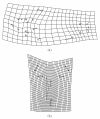The utility of geometric morphometrics to elucidate pathways of cichlid fish evolution
- PMID: 21716723
- PMCID: PMC3119416
- DOI: 10.4061/2011/290245
The utility of geometric morphometrics to elucidate pathways of cichlid fish evolution
Abstract
Fishes of the family Cichlidae are famous for their spectacular species flocks and therefore constitute a model system for the study of the pathways of adaptive radiation. Their radiation is connected to trophic specialization, manifested in dentition, head morphology, and body shape. Geometric morphometric methods have been established as efficient tools to quantify such differences in overall body shape or in particular morphological structures and meanwhile found wide application in evolutionary biology. As a common feature, these approaches define and analyze coordinates of anatomical landmarks, rather than traditional counts or measurements. Geometric morphometric methods have several merits compared to traditional morphometrics, particularly for the distinction and analysis of closely related entities. Cichlid evolutionary research benefits from the efficiency of data acquisition, the manifold opportunities of analyses, and the potential to visualize shape changes of those landmark-based methods. This paper briefly introduces to the concepts and methods of geometric morphometrics and presents a selection of publications where those techniques have been successfully applied to various aspects of cichlid fish diversification.
Figures



References
-
- Turner GF, Seehausen O, Knight ME, Allender C, Robinson RL. How many species of cichlid fishes are there in African lakes? Molecular Ecology. 2001;10(3):793–806. - PubMed
-
- Koblmüller S, Sefc KM, Sturmbauer C. The Lake Tanganyika cichlid species assemblage: recent advances in molecular phylogenetics. Hydrobiologia. 2008;615(1):5–20.
-
- Boulenger GA. Catalogue of the Fresh-Water Fishes of Africa in the British Museum (Natural History) Vol. 3. London, UK: British Museum (Natural History); 1898.
-
- Fryer G, Iles TD. The Cichlid Fishes of the Great Lakes of Africa: Their Biology and Evolution. Edinbourgh, UK: Oliver & Boyd; 1972.
-
- Greenwood PH. Morphology, endemism and speciation in African cichlid fishes. Verhandlungen der Deutschen Zoologischen Gesellschaft. 1973;66:115–124.
LinkOut - more resources
Full Text Sources
Research Materials

